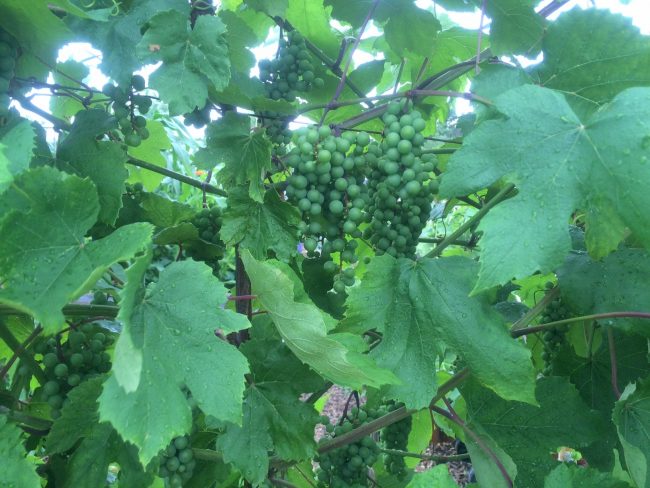Backyard Fruit Care Tips for Summer Season
By Vijai Pandian, Horticulture Extension Educator

Fruit clusters on Grapevine can easy be smothered by leaf growth in late summer. Selective leaf removal around the fruit clusters by mid-growing season is an effective way to open up the canopy. This reduces disease pressure and enhances fruit quality.
How to manage overgrown grapes: By mid to late summer, the grapevine smothers out the fruit clusters and tends to grow beyond its trellis. This leads to poor air circulation around the plant, blocking light penetration, and paving the way to fungal diseases like downy mildew and powdery mildew that decimate the fruits. Selective leaf removal around the fruit clusters by mid-growing season is an effective way to open up the canopy. This reduces disease pressure and enhances fruit quality. Leaf removal around the clusters can be done any time after fruit set and well before the onset of ripening. Typically 1-2 leaves around the fruit clusters per shoot are stripped to increase the fruit exposure to sunlight. However, removing too many leaves around each fruit cluster can lead to sunburned fruits. Ideally, 60-70% of fruit exposure to sunlight is good enough to enhance the fruit quality. Before leaf removal, secure any lateral shoots around the fruit clusters to the trellis or if needed prune those lateral shoots.
How to set a trap for spotted wing drosophila: Spotted wing drosophila (SWD), an invasive fruit fly from Southeast Asia, is a problematic pest for many fruit gardeners. It attacks many soft-skinned fruits like raspberries, blueberries, blackberries, grapes, peaches, and cherries close to its ripening stage and makes the fruit non-edible. The affected fruit contains the maggots of SWD and results in fruit rot. It is critical to monitor raspberries and other soft-skin fruits for SWD by mid-summer by setting traps and taking preventive measures. To set traps for SWD, drill about 10 holes (3/16” diameter) on the lid of a 32-ounce clear plastic container. Pour some yeast-sugar mix (one tablespoon active dry yeast and four tablespoons sugar in 12 ounces of water) as bait in the container. Another effective bait mix option is apple cider vinegar (2” deep in the container) with a few drops of unscented dish soap solution. Set the trap in a shaded area near the fruited canes. Make sure to check the traps daily for SWD, and once a week add some fresh bait in the container. If you’re not sure about what you caught in the trap, bring some samples to your local UW Extension office for diagnosis.
When to prune water sprouts in apple trees: Water sprouts are tough to manage in apple trees and it can be a hugely time-consuming process to prune them in cold winter periods. These upright shoots are vigorous in their growth and are formed on the main and lateral branches and quickly dense up to the apple tree canopy by late summer. Ideally, major pruning in apple trees is done between late winter and early spring when trees are still dormant, but you can stay ahead of the annual pruning operation and ease up the workload by removing the water sprouts in late July. This helps in opening up the dense canopy and allows more light penetration to enhance fruit quality. It is critical not to prune the water sprouts after early August as it can delay the tree’s dormancy process and makes it vulnerable to winter injuries. Also, make sure to disinfect your pruning tools with 70% rubbing alcohol before and after pruning each tree.
For more gardening info or plant health-related questions, contact us at:



